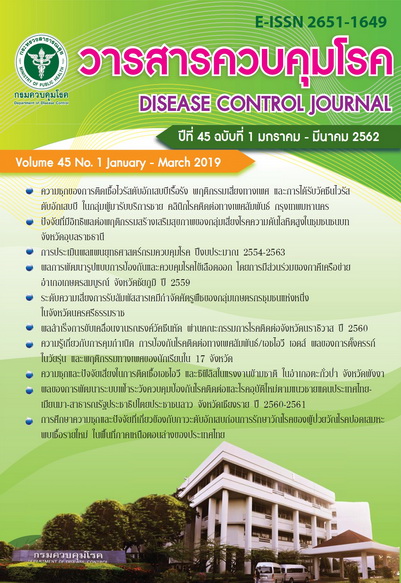Risk rating of pesticide exposure among agricultural workers in a community, Nakhon Si Thammarat Province
DOI:
https://doi.org/10.14456/dcj.2019.15Keywords:
agricultural workers, pesticides, risk ratingAbstract
This study aimed to evaluate risk rating of pesticide exposure among agricultural workers in one of the local communities in Nakhon Si Thammarat Province. The study was conducted from April to October 2016. A total of 202 farm workers participated in this study. The data were collected using structured questionnaires. Chemical hazard risk assessment was investigated according to a manual of recommended practice on assessment of the health risks arising from the use of chemicals hazardous to health at the workplace, Malaysia. The data obtained from this study were analyzed using descriptive statistics. The results showed that most of workers were male (59.9%) with age between 50-59 years (27.7%), and the duration of agricultural work experience between 10-20 years (32.2%). The most commonly used pesticide was abamectin, which accounts for approximately 63.9%. Carbofuran and paraquat dichloride were two pesticides classified at risk level 4, whereas abamectin, chlorpyrifos, glyphosate-isopropylammonium, copper hydroxide, carbendazim, and alphacypermethrin were classified at risk level 3. However, both risk levels are in the category 1, which is considered an unacceptable risk that needs to be addressed immediately. It is recommended that primary health care units work collaboratively with local administrative organizations to conduct the health surveillance program, annual pesticide exposure monitoring, and agricultural workers trainings including substitution of currently-used chemicals with less toxic chemicals, personal protective equipment selection, and chemical safety practices to prevent adverse health effects from pesticide exposure. The outcomes of this study could be used for determination of safety levels of pesticide exposure and a potential ban on the use of high-risk pesticides in the agricultural sector.
Downloads
References
2. Bureau of Occupational and Environmental Diseases, Department of Disease Control, Ministry of Public Health. Health effects from pesticides [Internet]. [cited 2018 Apr 4]. Available from: http://envocc.ddc.moph.go.th/contents/view/106 (in Thai)
3. The National Statistical Office. The informal employment survey 2017 [Internet]. [cited 2018 Jun 4]. Available from: http://www.nso.go.th/sites/2014/DocLib13/ด้านสังคม/สาขาแรงงาน/แรงงานนอกระบบ/แรงงานนอกระบบ_2560/Full_report2560.pdf (in Thai)
4. Panitcharoen T, Choikreua P. Occupational and environmental disease report by HOSxP program [Internet]. [cited 2018 Jun 5]. Available from: http://ryssurvey.com/vichakarn/ downloadq.php?f=ddc_201706271104262241_ 150_1001ca.pdf&fc=title%2027.pdf (in Thai)
5. Alavanja MC, Bonner MR. Pesticides and human cancers. Cancer Invest 2005;23:700–11.
6. Miligi L, Costantini AS, Veraldi A, Benvenuti A, Will, Vineis P, Cancer and pesticides: an overview and some results of the Italian multicenter case–control study on hematolymphopoietic malignancies. Ann NY Acad Sci 2006;1076:366–77.
7. Alavanja MC, Sandler DP, McMaster SB, Zahm SH, McDonnell CJ, Lynch CF, et al. The agricultural health study. Environ Health Perspect 1996;104:362–9.
8. Martenies SE, Martenies, Perry MJ. Environmental and occupational pesticide exposure and human sperm parameters: a systematic review. Toxicology 2013;307:66-73.
9. Tritipsombut J, Gabklang P, Boonkerd S, Oapsuwan A. The study of knowledge, attitudes and pesticide usage behaviors among the agricultural workers at Huay Sam Kha Village, Tub Ruang Sub-district, Phra Thong Kum District, Nakhon Ratchasima Province. Srinagarind Med J 2014;29:429-34. (in Thai)
10. Tanaree W, Jaitia S. Health impact assessment on agricultural chemical utilitied of farm crops Muangkaen Municipality Maetang District, Chiang Mai Province [dissertation]. Chiang Mai: Chiang Mai Rajabhat University; 2011. 78 p. (in Thai)
11. Bureau of Occupational and Environmental Diseases, Department of Disease Control, Ministry of Public Health. Report on the situation of diseases and health hazards from occupations and the environment 2016 [Internet]. [cited 2018 Jun 6]. Available from: http://envocc.ddc.moph.go.th/uploads/situation/01_envocc_situation_59.pdf (in Thai)
12. Nakhon Si Thammarat Provincial Health Office. Toxic effect of pesticides 2017 [Internet]. [cited 2018 Nov 24]. Available from: https://nrt.hdc.moph.go.th/hdc/reports/report.php? source=pformated/format1.php&cat_id=f16421e617aed29602f9f09d951cce68&id=46914a29aebb9e55230cc408f59f2d39 (in Thai)
13. Office of Agricultural Economics. Agricultural utilization area of the province 2015 [Internet]. [cited 2018 Nov 24]. Available from: http://oldweb.oae.go.th/download/ use_soilNew/soiNew/landused2556.html (in Thai)
14. Phengsawat W. Research methodology. Bangkok. Suweeriyasan; 2008. (in Thai)
15. Department of Occupational Safety and Health, Ministry of Human Resources Malaysia. Assessment of the health risks arising from the use of hazardous chemicals on the workplace [Internet]. [cited 2016 Jun 2]. Available from: http://www.dosh.gov.my/images/dmdocuments/glx/garispanduan27.pdf
16. Simla W, Boonrod T. Pesticide preventive behaviors of agriculturists at Laem Tanot Sub-district, Khuankhanun District, Phatthalung Province. The 8th Academic conference Kasetsart University Kamphaeng Saen Campus; 2011 Dec 8-9; Kasetsart University Kamphaeng Saen Campus, Nakhon Pathom. Kamphaeng Saen: 2012. p 1469-79. (in Thai)
17. Praneetvatakul S, Tipraksar P, Sirichinda A, Sinphurmsukskul N, Chanjam C, Boonyaratsewee T. Policy options for environmentally friendly pest management in Thailand [Internet]. [cited 2018 Jun 8]. Available from: https://kukr.lib.ku.ac.th/db/index.php?/BKN/search_detail/result/370405 (in Thai)
18. Health and Consumer Protection Committee and BIOTHAI. Comments and recommendations for the protection of consumers from the pesticides; carbofuran, methomyl, EPN and dicrotophos [Internet]. [cited 2018 Jun 8]. Available from: http://www.thaipan.org/sites/default/files/conference2555/conference2555_0_18.pdf (in Thai)
19. Thailand Pesticide Alert Network. 4 pesticides and countries that discontinue use or not registered [Internet]. [cited 2018 Nov 23]. Available from: https://thaipan.org/movement/167 (in Thai)
20. Hazardous Substance and Waste Management Division, Pollution Control Department, Ministry of Natural Resources and Environment. Paraquat. Bangkok: Integrated Promotion Technology; 1998.
21. Food And Agriculture Organization of The United Nations. Paraquat Dichloride [Internet]. 2008 [cited 2018 Jun 8]. Available from: http://www.fao.org/fileadmin/templates/ agphome/documents/Pests_Pesticides/Specs/Paraquat08.pdf
Downloads
Published
How to Cite
Issue
Section
License
Articles published in the Disease Control Journal are considered as academic work, research or analysis of the personal opinion of the authors, not the opinion of the Thailand Department of Disease Control or editorial team. The authors must be responsible for their articles.






